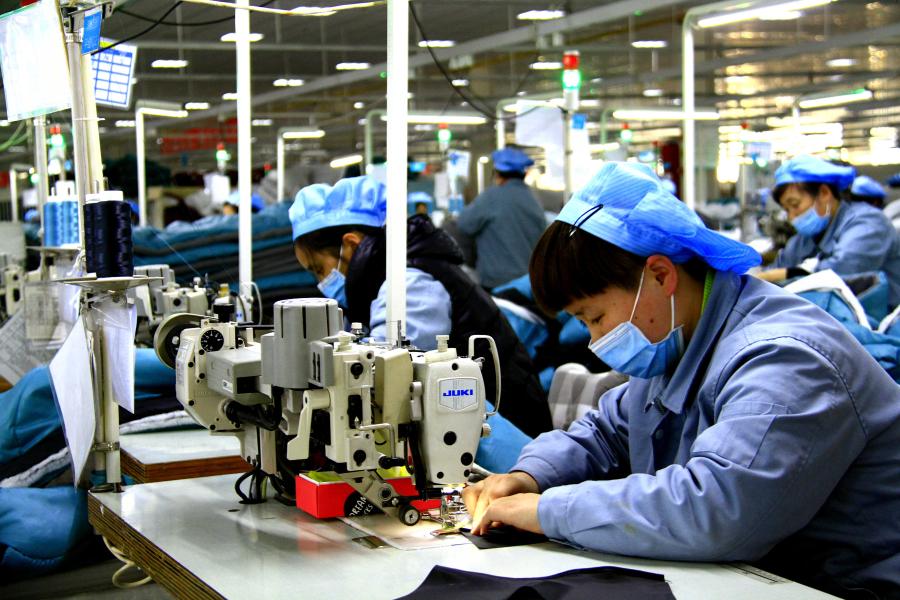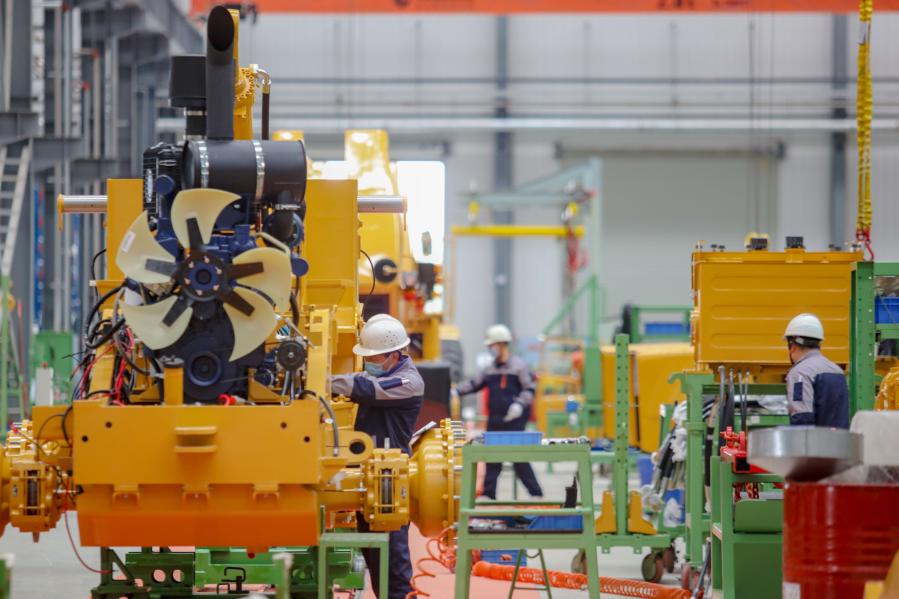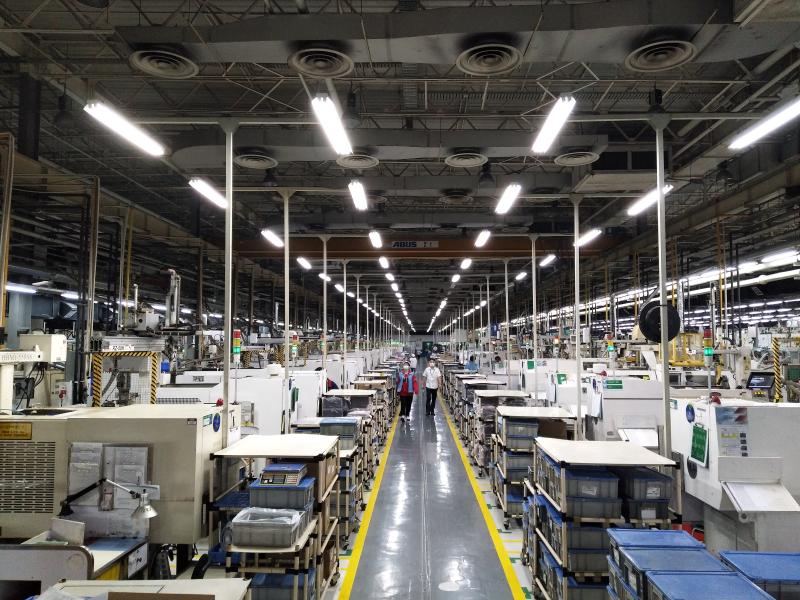-- To prevent the sporadic resurgence of COVID-19, China had encouraged people to stay put over the Spring Festival holiday this year, which lasted from Feb. 11 to Feb. 17.
-- Thanks to the stay-put measure, manufacturing enterprises in the southern Chinese city of Dongguan, widely known as the "factory of the world," have resumed production straight after the holiday, weeks earlier compared to the usual schedule.
-- The stay-put measure has helped enterprises shore up holiday production, eased post-holiday labor shortages, and improved order delivery capacities, ushering in a "warm spring" for China's manufacturing sector.
by Xinhua writers Che Xiaohui, Huang Haoyuan, Zhan Yijia, Ma Xiaocheng, Xu Ruiqing
GUANGZHOU/HEFEI, Feb. 19 (Xinhua) -- With machines roaring, factories in the southern Chinese city of Dongguan, known as the "factory of the world," are heating up production.
The scenes are in sharp contrast to the usual happenings as factories traditionally shut down for a couple of weeks after the Chinese Spring Festival holiday.
To prevent the sporadic resurgence of COVID-19, China had encouraged people to stay put over the holiday this year, which lasted from Feb. 11 to Feb. 17. Dongguan, a city with more than 11,000 major industrial enterprises, has more than 5 million registered workers, of which over 3 million chose not to visit their hometowns during the holiday.
According to a survey covering the 200 largest manufacturing enterprises in Dongguan, about 60 percent were operational during the holiday. Besides, more factories quickly resumed production right after the holiday, at least two weeks earlier than the usual schedule.
The humming factories in Dongguan offer a glimpse of the bustling production activities across the country after the holiday. The stay-put measure has helped enterprises shore up holiday production, eased post-holiday labor shortages, and improved order delivery capacities, ushering in a "warm spring" for China's manufacturing sector.
HUMMING FACTORIES
Dongguan's economic growth is highly reliant on foreign trade, with many factories surviving on export orders. In previous years, enterprises would cut orders in the first quarter of the year due to post-holiday labor shortages.

A laborer works at a workshop of AE (Tianjin) Automotive Equipment Co., Ltd. in Tianjin, north China, Feb. 14, 2021. (Xinhua/Sun Fanyue)
However, things have changed this year.
"Over 60 percent of our employees didn't go back home this Spring Festival. Our factory has been running except the holiday period," said Zhou Hongchun, vice general manager of Huamei Group, a food company in Dongguan.
Zhou added that sufficient workers have increased the company's capability to deliver orders and ensured quick resumption of production after the holiday.
"We have more than 1 million yuan (about 154,900 U.S. dollars) of subsidies for employees who chose to stay, but the cost is much lower compared with that of employing new workers after the holiday," Zhou said.
Similar to the food company, Hefei Chang'an Automobile Co., Ltd. in east China's Anhui Province also saw boisterous production activities.

Staff workers work at a home textiles company in Binzhou, east China's Shandong Province, Feb. 17, 2021. (Photo by Zhang Chunfeng/Xinhua)
The automaker resumed production on Feb. 14. More than 1,700 employees, or around 85 percent of its staff, clocked in on the first day of work, including over 800 migrant workers who stayed during the holiday.
The manufacturing capacity has returned to the pre-holiday level, with 703 vehicles rolled off the production line on Tuesday, according to the company.
"Another production line resumed operation on Wednesday, with a capacity of around 300 units a day. Cars rolled off from this assembly line will be exported to Saudi Arabia, Chile and Brazil," said Xue Wen, an engineer with the company.
"WARM SPRING" FOR MANUFACTURING SECTOR
Dongguan is considered an important indicator for China's manufacturing industry. In the first quarter of 2020, the value-added industrial output of the city's major industrial enterprises fell by 17.9 percent year on year due to the impact of COVID-19.
However, with the pandemic under control and the gradual resumption of production, the growth decline of the value-added output of its major industrial enterprises narrowed month by month, with an annual decline of 1.1 percent last year.

Employees work at a machinery company in Suining, southwest China's Sichuan Province, Feb. 18, 2021. (Photo by Liu Changsong/Xinhua)
"With the pandemic raging globally, many overseas factories are still closed, and orders have been shifted to China, which has stimulated our production," said Li Zhongquan, general manager of Ampenol FCI Connectors Dongguan. "We didn't stop production even for a single day during the COVID-19 outbreak."
In 2020, the company's operating revenue increased 30 percent year on year to 1.63 billion yuan. To complete the increasing orders this year, the company resumed production right after a three-day break.
Peng Yiping, general director of Guangdong NBTM Huajing New Materials, a company mainly producing smart wearable devices, is confident about this year's market prospect.
The orders have continued to increase, Peng said, noting that the company's output is expected to reach 182.5 million yuan in the first four months of this year, an increase of 53 percent compared to the same period last year.

Employees work at an electronics components enterprise in Shatian Town of Dongguan, south China's Guangdong Province, Feb. 2, 2021. (Xinhua)
Echoing similar thoughts, Zhan Zhibin, director of the bureau of industrial and information technology of Dongguan, said the manufacturing enterprises will have a bright market prospect this year despite the lingering impact of the COVID-19 epidemic.
The city's industrial investment rose 11 percent year on year in 2020, injecting impetus into its manufacturing industry, Zhan added.
"We expect the city's GDP to increase by 6 percent this year, with the value-added output of its major industrial enterprises up 5 percent, maintaining a strong growth momentum," said Zhan.
(Video reporters: Zhan Yijia, Wang Ruiping, Wang Pan; Video editors: Yang Zhixiang. Liu Fangqiang also contributed to the story)■




